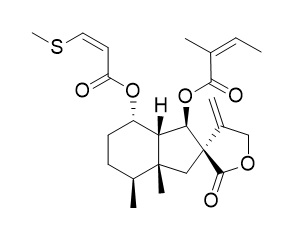Bakkenolide IIIa
Bakkenolide IIIa has antioxidant, and neuroprotective effects, it protects against cerebral damage by inhibiting AKT and ERK1/2 activation and inactivated NF-κB signaling.
Inquire / Order:
manager@chemfaces.com
Technical Inquiries:
service@chemfaces.com
Tel:
+86-27-84237783
Fax:
+86-27-84254680
Address:
1 Building, No. 83, CheCheng Rd., Wuhan Economic and Technological Development Zone, Wuhan, Hubei 430056, PRC
Providing storage is as stated on the product vial and the vial is kept tightly sealed, the product can be stored for up to
24 months(2-8C).
Wherever possible, you should prepare and use solutions on the same day. However, if you need to make up stock solutions in advance, we recommend that you store the solution as aliquots in tightly sealed vials at -20C. Generally, these will be useable for up to two weeks. Before use, and prior to opening the vial we recommend that you allow your product to equilibrate to room temperature for at least 1 hour.
Need more advice on solubility, usage and handling? Please email to: service@chemfaces.com
The packaging of the product may have turned upside down during transportation, resulting in the natural compounds adhering to the neck or cap of the vial. take the vial out of its packaging and gently shake to let the compounds fall to the bottom of the vial. for liquid products, centrifuge at 200-500 RPM to gather the liquid at the bottom of the vial. try to avoid loss or contamination during handling.
Bull. Pharm. Sci., Assiut University2020, 43(2):149-155.
Bioorg Chem.2024, 145:107184.
Appl Microbiol Biotechnol.2016, 100(9):3965-77
Plants (Basel).2023, 12(22):3877.
Chemistry of Plant Raw Materials2019, 4:135-147
Int J Mol Sci.2019, 20(23):E6071
Molecules.2019, 25(1):E103
Nutrients.2024, 16(7):965.
Pharmaceuticals (Basel).2021, 14(7):633.
Food Sci Biotechnol.2023, 32(7):997-1003.
Related and Featured Products
CNS Neurosci Ther. 2015 Dec;21(12):943-52.
Bakkenolide-IIIa Protects Against Cerebral Damage Via Inhibiting NF-κB Activation.[Pubmed:
26511680 ]
This study was designed to examine the neuroprotective effects of Bakkenolide IIIa, a major novel compound extracted from the rhizome of P. trichinous.
METHODS AND RESULTS:
Transient focal cerebral damage model in rats and oxygen-glucose deprivation (OGD) in cultured hippocampal neurons were performed. The amount of apoptotic neurons was determined using TUNEL assay. The expressions of Bcl-2, Bax, Akt, ERK1/2, IKKβ, IκBα were measured using Western blot. The nuclear translocation and activation of NF-κB was measured using a fluorescence microscope and electrophoretic mobility shift assay (EMSA). Bakkenolide IIIa (4, 8, 16 mg/kg; i.g.) was administered immediately after reperfusion could reduce the brain infarct volume, and the neurological deficit, as well as a high dose of Bakkenolide IIIa, increases the 72 h survival rate in cerebrally damaged rats. In vitro data demonstrated that Bakkenolide IIIa could increase cell viability and decrease the amount of apoptotic cells in cultured primary hippocampal neurons exposed to OGD. Bakkenolide IIIa also dose-dependently increased the ratio of Bcl-2 to Bax. These results indicated that inhibition of apoptosis partly mediated the neuroprotection of Bakkenolide IIIa. Furthermore, Bakkenolide IIIa inhibited the phosphorylation of Akt, ERK1/2, IKKβ, IκBα, and p65 in cultured hippocampal neurons exposed to OGD. Bakkenolide IIIa not only inhibited the nuclear translocation of NF-κB in cultured neurons exposed to OGD, but also inhibited the activation of NF-κB in peri-infarct area in cerebrally damaged rats.
CONCLUSIONS:
Collectively, our findings indicated that Bakkenolide IIIa protects against cerebral damage by inhibiting AKT and ERK1/2 activation and inactivated NF-κB signaling.
Planta Med. 2009 Feb;75(3):230-5.
Bakkenolides from Petasites tricholobus and their neuroprotective effects related to antioxidant activities.[Pubmed:
19085813]
Four novel bakkenolides - bakkenolide Ia ( 1), bakkenolide IIa ( 2), Bakkenolide IIIa ( 3) and bakkenolide IVa ( 4) - were isolated from the extract of the rhizome of Petasites tricholobus.
METHODS AND RESULTS:
The structures were characterized by using NMR ( (1)H, (13)C, (1)H- (1)H COSY, HMQC, HMBC, and NOESY) and mass spectrometry. The neuroprotective activity of the compounds 1 - 4 was assayed with primary cultured neurons exposed to oxygen-glucose deprivation and oxidative insults. Antioxidant activity of the bakkenolides was evaluated by cell-free bioassays.
CONCLUSIONS:
The IN VITRO assay results showed that all these compounds exhibited significant neuroprotective and antioxidant activities. To our knowledge, this is the first report on the neuroprotective and antioxidant activities of bakkenolides.



